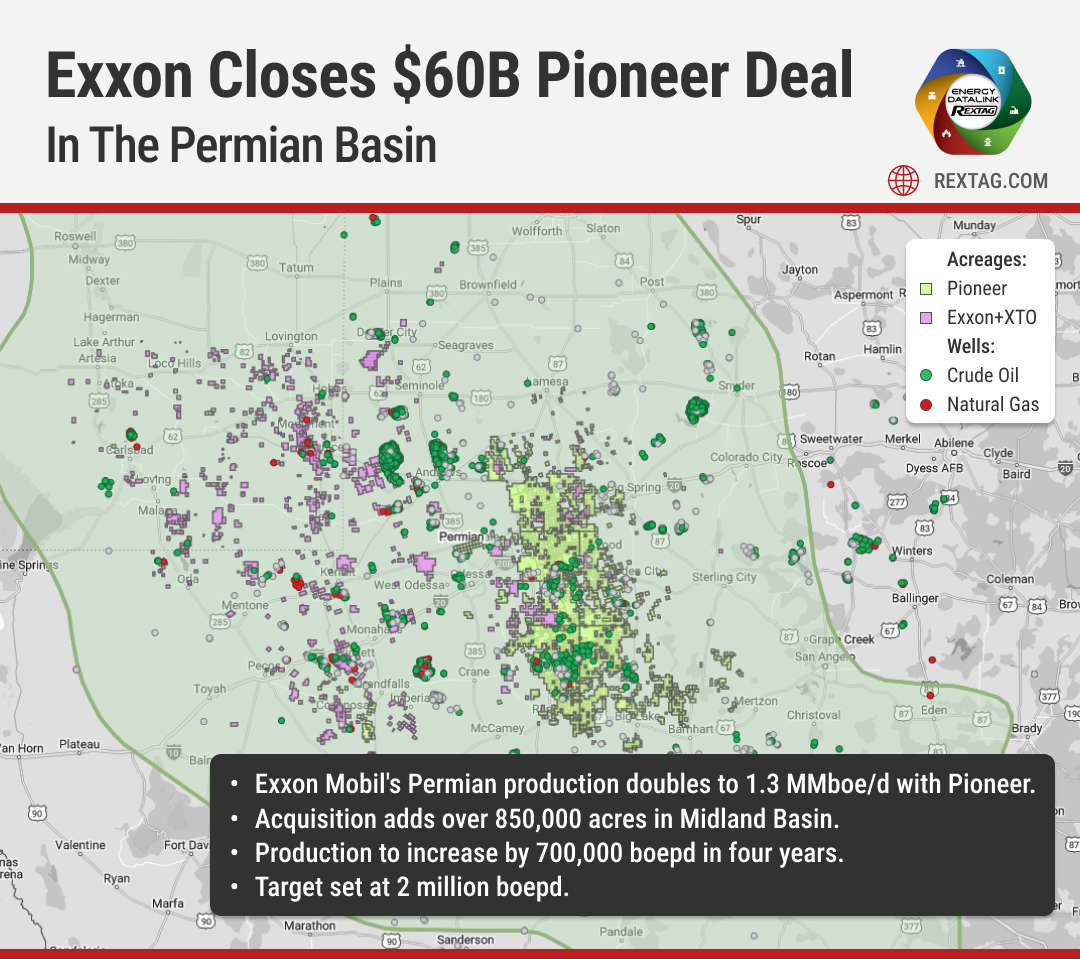Comprehensive Energy Data Intelligence
Information About Energy Companies, Their Assets, Market Deals, Industry Documents and More...
Exxon Mobil and the $60 Billion Deal That Changes Everything in Permian
05/08/2024
- The deal speeds up Pioneer's environmental targets, moving their net-zero carbon goal from 2050 to 2035.
- Exxon Mobil plans to increase its production to around 2 million barrels per day by 2027 in the Permian region.
- The company expects to produce oil at less than $35 per barrel in the Midland Basin, much lower than the regional average break-even cost of $62 per barrel.
- Exxon has been leading in drilling longer and more efficient wells, using advanced strategies like the "cube" development.
Exxon Mobil recently completed its acquisition of Pioneer Natural Resources, a deal worth about $60 billion. This transaction, which is the biggest in shale oil history, significantly changes the competitive landscape in the Permian Basin, a major oil field.
This marks Exxon Mobil's largest deal since its $84.4 billion merger with Mobil Corp. in 1999. With this acquisition, Exxon Mobil's production in the Permian Basin will double to 1.3 million barrels of oil equivalent per day.
The deal enhances Exxon Mobil's position in the Midland Basin of the Permian, where Pioneer has significant holdings across more than 850,000 acres. Before acquiring Pioneer, Exxon Mobil had a stronger presence in the Delaware Basin of West Texas and New Mexico. This presence was bolstered by purchasing land from the Bass family for $6.6 billion in 2017.
Exxon also holds assets in the Central Basin Platform of the Permian, which includes both acreage and older vertical wells.
The merger between Exxon Mobil and Pioneer Natural Resources was allowed to proceed despite close examination by the U.S. Federal Trade Commission (FTC).
The FTC had raised concerns that Sheffield tried to work with the oil group OPEC and its allies to cut oil and gas production to boost profits. According to the FTC, Sheffield had numerous communications, including hundreds of text messages with OPEC members, discussing oil market conditions, pricing, and production levels. He was quoted saying that he hoped actions in Texas might encourage OPEC and major producers like Saudi Arabia and Russia to also cut production.
Pioneer expressed disagreement and surprise over the FTC's allegations, stating that the complaint misunderstood the dynamics of both U.S. and global oil markets and Sheffield's intentions.
Despite the controversy, Pioneer emphasized that it would not hinder the merger process. The company stated that Sheffield would prioritize the interests of investors, employees, and the U.S. energy sector's competitive stance over his interests.
If you are looking for more information about energy companies, their assets, and energy deals, please, contact our sales office mapping@hartenergy.com, Tel. 619-349-4970 or SCHEDULE A DEMO to learn how Rextag can help you leverage energy data for your business.
TOP 2022 vs 2023 Permian Producers Overview by Rextag
![$data['article']['post_image_alt']](https://images2.rextag.com/public/blog/R242_Blog_Permian Producers Overview by Rextag.png)
The Permian Basin, America's prime oil region, faced significant challenges during the COVID-19 pandemic. The industry saw a drastic reduction in rigs and fracking crews and had to close some operations as oil prices plummeted, leading to widespread restructuring. Now, the Permian is making a strong comeback. Over the last three years, exploration and production companies (E&Ps) have increased their drilling activities. They're focusing on spending wisely and maximizing returns to their investors. The Permian's role is crucial. It was projected to contribute over 5.98 million barrels of oil per day in December, making up about 62% of the total oil production in the Lower 48 states, as per the EIA.
Baker Hughes Confirms a Third Weekly Decline in US Oil and Gas Rigs
![$data['article']['post_image_alt']](https://images2.rextag.com/public/blog/BLOG_Baker Hughes Confirms a Third Weekly Decline in US Oil and Gas Rigs.jpg)
In a recent announcement, energy services firm Baker Hughes stated that U.S. energy companies have decreased the number of operating oil and gas rigs for the third successive week. This development marks the first such consistent reduction since early September. As of October 6, the count for oil and gas rigs, considered a precursor to future production levels, has seen a decline by four, positioning it at 619. This is the lowest figure recorded since February of the preceding year. The overall rig count has decreased by 143 or 19% when compared to last year's statistics.
![$data['article']['post_image_alt']](https://images2.rextag.com/public/blog/328_Blog_Why Are Oil Giants Backing Away from Green Energy Exxon Mobil, BP, Shell and more .jpg)
As world leaders gather at the COP29 climate summit, a surprising trend is emerging: some of the biggest oil companies are scaling back their renewable energy efforts. Why? The answer is simple—profits. Fossil fuels deliver higher returns than renewables, reshaping priorities across the energy industry.
![$data['article']['post_image_alt']](https://images2.rextag.com/public/blog/327_Blog_Oil Market Outlook A Year of Growth but Slower Than Before.jpg)
The global oil market is full of potential but also fraught with challenges. Demand and production are climbing to impressive levels, yet prices remain surprisingly low. What’s driving these mixed signals, and what role does the U.S. play?
![$data['article']['post_image_alt']](https://images2.rextag.com/public/blog/326_Blog_USA Estimated Annual Rail CO2 Emissions 2035.jpg)
Shell overturned a landmark court order demanding it cut emissions by nearly half. Is this a victory for Big Oil or just a delay in the climate accountability movement?